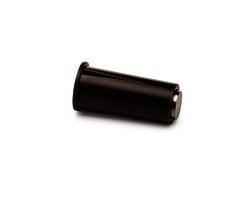What Do Normally Closed and Normally Open Mean?
Normally opened or closed refers to the state of a contact attached to an opening. When talking about circuits or zones on an alarm panel, "normal" indicates the normal state of the opening being protected. For doors and windows, this is usually closed. Fire devices are normally open.
For the most part, normally closed contacts are used on normally closed protection points, such as doors and windows. If for no other reason, because it's much less confusing! What this means is, that if you have a magnetic contact, which usually consists of a reed switch inside a plastic housing, and a separate magnet in a matching plastic housing, and it is connected to a door, when the door is closed, the reed switch within the contact is closed, and when the door is opened, meaning that the magnet and the reed switch portion of the contact are separated, then the reed switch within the contact is also open.
Put another way, if you have a meter that is capable of displaying when it sees a closed circuit (short), or an open circuit, and you attach the meter leads to the wires or screw terminals for the reed switch portion of a contact. When the magnet is next to the contact (the "normal" position) if you read an open on the wires or terminals, then the device is normally open, and if you read a short, then the device is normally closed.
Why do we care? The alarm panel does what we tell it to do, and different panels have different capabilities when it comes to wired zones. Older panels usually require that an End of Line Resistor be installed on each wired zone. The resistor orientation (wired in series or in parallel) depends on whether the contact or contacts on the circuit were Normally Open (NO), or Normally Closed (NC). So, in order to wire the zone correctly, you had to know the contact's normal state.
Newer panels offer the option of either using End of Line Resistors, or specifying NO, or NC. There may be other options available, but we won't discuss those here. In order to properly program and wire each zone, we must know what the normal state of each contact is. For example, if we tell the panel to treat a zone as Normally Closed, we're telling the panel that when it sees a short on the zone, this is the normal, non-faulted state, and when it sees an open on the zone, it should show that zone as being faulted. If this happens to a burglary zone while the system is armed, then it will trigger either the entry delay, or an alarm depending on the zone's programming. If we program for Normally Closed, but wire Normally Open, the system will tell us the door is faulted when it's closed, and that it is in the normal condition when it's actually open.
When replacing an existing contact, you also need to know if the contact being replaced was normally open or closed, especially if more than one contact is wired into a single zone. It is difficult, and in some cases impossible, to mix NO and NC contacts on a single zone. When buying contacts, look for Form C, SPDT (Single Pole, Double Throw) contacts if you require a normally open device. Honeywell contacts usually indicate Form C with a -2 after the part number. Form A, SPST (Single Pole, Single Throw) contacts are always normally closed. There are hundreds of different contacts to choose from in various sizes and configurations, from surface mount, to recessed mount. Many of these are offered by Alarm Grid.

Did you find this answer useful?
We offer alarm monitoring as low as $10 / month
Click Here to Learn MoreRelated Products


















Related Categories
- Answered
- Answered By
- Julia Ross













